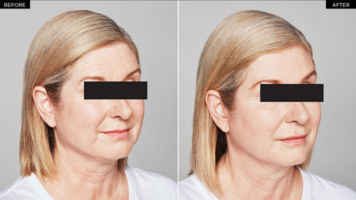Why lift with RESTYLANE®?
Our facial bones give shape and structure to our face. As we age, bone resorption increases, leading to loss of definition and contours, especially towards the back of the jaw. Another consequence of aging is volume loss in the mid face, which could lead to flat cheeks, saggy skin and jowling. Creating a lift with RESTYLANE® will compensate for these changes. Another reason for lift with RESTYLANE® could be that you have a desire to enhance your facial features and bring out your individuality, no matter your age.
Restylane® DEFYNE™ and Restylane® LYFT™ can be tailored to an individual look to give you the freedom to be original. Restylane® LYFT™ is our firmest dermal filler and is suited for lifting the cheeks, enhancing the jawline or chin, or reducing the appearance of wrinkles.2-4 If you have a thinner tissue coverage, Restylane® DEFYNE™ could be preferred as it is slightly softer and more flexible.
Treatments with Restylane® DEFYNE™ can last up to 1 year.5* Restylane® LYFT™ can last up to 24 months with one retreatment at 12 months.6^
*In approximately 80% of study participants
^In at least 88% of study participants

RESTYLANE® treatment areas
Restylane® and Restylane® LYFT™ are dermal fillers that give precise results, creating a projection or a lift of the treated area. Areas that can be treated are, for example, the chin, jawline and cheeks.

RESTYLANE® treatment areas

Restylane® and Restylane® LYFT™ are dermal fillers that give precise results, creating a projection or a lift of the treated area. Areas that can be treated are, for example, the chin, jawline and cheeks.
Your RESTYLANE® treatment
A treatment with RESTYLANE® takes approximately 15-45 minutes, depending on the area that will be treated. Sometimes you might need a touch-up treatment about two weeks after the initial treatment to optimise your results. RESTYLANE® fillers contain a local anesthetic, lidocaine, that takes away most of the discomfort during treatment.
Immediately after your dermal filler treatment, you may experience some injection-related side effects, such as redness, swelling, pain, bruising or tenderness at the treatment site. These side effects usually disappear within one week after injection. Though fillers are minimally invasive, they still carry some risks. Before the treatment, you should discuss all possible risks and benefits with your healthcare practitioner.
Restylane gives you long-lasting but non-permanent results, meaning that you can continuously refine your looks.

How it works
Hyaluronic acid is a substance that has a unique ability to bind water. Hyaluronic acid occurs naturally in our bodies and in all layers of our skin. It keeps our body tissues soft, hydrated and flexible. However, as we age, the body’s ability to produce hyaluronic acid lessens, leading to dry and thinner skin and loss of youthful volume.
Native hyaluronic acid in the body degrades quickly, in one to two days. To make the hyaluronic acid in Restylane® last longer, Galderma has used stabilisation technologies that delay degradation; where Restylane® DEFYNE™ can last up to a year5, and Restylane® LYFT™ for up to two years with one retreatment2*. Restylane® DEFYNE™ and Restylane® LYFT™ contain hyaluronic acid gels that provide good support to maintain structure and projection.
Restylane® was the first ever non-animal stabilised hyaluronic acid filler when it was launched in 1996, a brand that has the longest history on the market compared to other other hyaluronic acid dermal filler brands.
*Full face combination treatment with Restylane® and Restylane® LYFT™, with one retreatment at 12 months


What to ask your practitioner
Here are a few questions that we recommend you to ask your healthcare practitioner:
- What results can I expect from the treatment?
- What happens during the treatment?
- Could my medical history or previous treatments affect or prevent treatment?
- Are there any side effects and precautions that I should know about?
- Is there anything I should do before and after treatment?
- Any other question you may have.
You will also find detailed information about treatment with Restylane fillers in our FAQ section below.

Frequently asked questions
How should I prepare before my consultation?
You will always have a consultation before your first treatment. Think through what you want to achieve and the questions you may have. Your healthcare practitioner will discuss with you the benefits and potential side effects of dermal fillers and how they can be used to achieve your own individual aspirations. You will also be asked about your medical history. When you leave your consultation, you should feel well-informed about Restylane fillers and you should know what results to expect.
What should I bear in mind when considering a treatment?
First of all, you should always contact a qualified healthcare practitioner to be assured that your dermal filler treatment will be performed correctly. You could always search in national registers of licensed aesthetic treatment specialists. Your treatment should be performed in a medical environment that affords you privacy and is spotlessly clean. You may want to request to see your chosen practitioner’s training certificate and insurance certificate to ensure that he or she is appropriately trained and insured for the treatment.
Who is qualified to administer Restylane treatments?
Only a medically qualified practitioner should perform Restylane treatments. This may include plastic surgeons, cosmetic clinicians, dermatologists, cosmetic dentists, or aesthetic nurses. Please see our list of aesthetic clinics close to you.
What should I expect from my chosen healthcare practitioner?
- You should be informed of the possibilities and limitations of treatments with hyaluronic acid.
- You should receive information about possible side effects and precautions for treatment.
- You should be informed of the cost of the treatment and possible follow-up treatments.
- Your questions should be answered to your full satisfaction.
What precautions should my healthcare practitioner advise me about?
There are several important precautions to discuss with your healthcare practitioner to ensure satisfactory results and minimise the risk of complications. Discuss the following with your healthcare practitioner:
- If you are taking immunosuppressive medications
- If you are taking aspirin, nonsteroidal anti-inflammatory drugs (NSAIDs) or any other medication or dietary supplement (eg. fish oil, turmeric, gingseng) that affects bleeding
- If you have a history of anaphylaxis or multiple severe allergies, including allergy to streptococcal proteins, hyaluronic acid, lidocaine or other local anaesthetics
- If you are pregnant, planning to be pregnant, or breastfeeding
- If you have any questions about precautions related to the treatment
How is Restylane administered?
First, the healthcare practitioner disinfects the area to be treated. A small amount of the appropriate Restylane filler is then injected into the skin through a fine needle or blunt micro-cannula to fill wrinkles, add volume, shape your face or fill your lips. After the injection, your practitioner may gently massage the treated area to even out the result.
Our portfolio of products

Relax
Relax the tension of facial muscles associated with frown lines and crow´s feet to show how you truly feel inside.

Refresh
Refresh your skin from within with a boost of deep hydration, for a refreshed and vibrant look that lasts.

Renew
Renew the structure of your skin with a collagen activator that gradually builds the foundation of the youthful, firmer you.
Are you looking for a clinic?
References
- Data on File, MA-39364.
- Huang S and Tsai T. J Drugs Dermatol. 2020;19(9):836–842.
- Weiss et al. Dermatol Surg 2016;42:699–709.
- Nikolis et al. Aesthet Surg J Open Forum 2020;2(1):ojaa005.
- Ascher et al. Dermatol Surg 2017;43:389–395.
- Cartier et al. J Drugs Dermatol. 2012 Jan;11(1 Suppl): s17-26.
